HAND REARING KITTENS
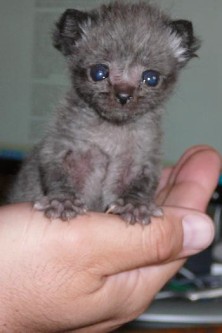
Information presented here has been provided by human foster mothers, veterinary staff and cat shelter workers. Many hand-rearing articles are aimed at breeders or contain veterinary terms. My own experience is related to cat rescue/shelter work where I have helped in supplementary feeding or emergency care of kittens. I have realised that many people reading this article will be working in less-than-ideal conditions and will have no access to certain equipment of supplies. I have tried to write in plain English, explaining common veterinary/medical terms as I go.
There is a great deal of information on the web about hand-rearing kittens and some details vary according to the writer's experiences. In some of the links and resources you will find diagrams of how to tube-feed kittens and how to stimulate elimination. I have included specific information regarding problem cases e.g. premature kittens. General information on hand-rearing kittens can be found at:
Feline Advisory Bureau - hand Rearing Kittens
The Cat Site - Premature Kittens
http://www.tasc.freeservers.com/forbreeders/Kittens.htm (has many links)
Some of the information here can be found in "Nursing and Hand Rearing Newborn Kittens" by Betty Bloomfield which is an invaluable source of information. Ms Bloomfield has a vast amount of experience with newborn kittens and puppies. Her book is available from http://www.amazon.co.uk (but not from amazon.com) and costs approximately UKŁ6.00 + p&p. If you aren't in the UK, this book is well worth the cost of shipping.
The photos in this article were taken at Chelmsford Cats Protection (League) unless otherwise stated. Many thanks to Jodi Olesen for the use of the "Kitten in Hand" photos.
REASONS FOR HAND-REARING KITTENS
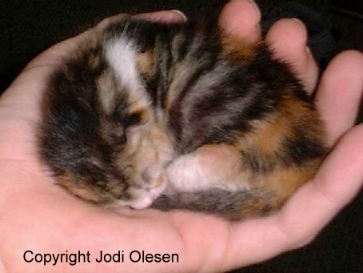
Newborn kittens are tiny and helpless. They are deaf, blind and totally dependent on their mother for food, warmth and protection. Normally they are cared for by their mother. She is on hand 24/7 to care for them and her milk changes as they grow. When confronted with orphaned kittens first try to find a surrogate feline mother. A local rescue organization or local vets may know of a lactating mother cat that may take the kittens. Only if this is not possible should you attempt to hand-rear kittens. The task of hand-rearing kittens can be daunting - they need constant care and will put great demands on your time and energy. At first they need to be fed every couple of hours so you will not be getting much sleep.
Do not raise kittens simply because you feel sorry for them. Only attempt to rear them if you plan to keep them, or they have a decent chance of finding homes and they have a good quality of life. Even if they present no actual problems to a hand-rearer, the overpopulation situation or local attitudes to cat care may make it more humane to euthanize abandoned (probably unwanted by mother cat's owner) kittens. It is far more cruel to hand-rear a kitten and then to abandon it; hand-reared kittens are even less able to adapt to a feral life than are kittens raised by their natural mother.
There are various reasons for hand-rearing kittens either from birth or during development. Sometimes you need to assist a mother in rearing her kittens i.e. supplementary feeding only. Other reasons include:
Note: Kittens have sometimes been successfully raised by small nursing bitches or a non-nursing bitch has helped with the cleaning, elimination and keeping warm aspects of kitten care. This is the exception not the rule. If you do have such a dog, you will already know her reaction to kittens and the extent to which she helps. Otherwise, do not tempt fate.
WHEN NOT TO HAND REAR
There are some cases where a kitten or kittens should be euthanized at birth. The following list is not exhaustive. In some cases the decision is difficult. In a few, surgery may be possible (e.g. if it is not a genetic condition and the kitten is important to a breeding program).
Some lesser abnormalities (eyes, ears, brain-damage, spinal problems) do not show up until later on. Twisted limbs and joints can usually be rectified with physiotherapy and splinting, or with amputation if only a single limb is affected; the joints are still being formed in the weeks immediately after birth.
Nervous or first time mothers may reject or abandon some or all kittens. In large litters, some kittens may be pushed out, become chilled and be ignored by the mother. Some mothers reject weak kittens which cannot compete against stronger, more active siblings. If a kitten is continually rejected by an experienced mother cat rearing a small litter, the mother may have sensed an abnormality. If you do attempt hand-rearing, be prepared for the worst.
PRIORITISE
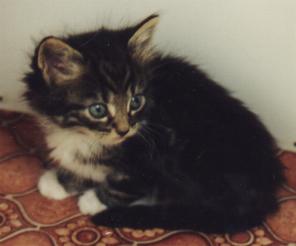
If you are involved in cat rescue and have limited means (financial or facilities) decide on you priorities.
If the kittens are poorly, you have little time and the overpopulation state is such that homes are few and far between, your only option may be euthanasia in order to save the lives of kittens and cats which are already independent of such intensive care.
If the overpopulation state is such that late abortion of females is necessary, or if physical trauma means a mother must have an emergency caesarian pre-term, agree beforehand what is to happen to the kittens if they are living. Rather than leave viable pre-term/aborted kittens to die, ask your vet to either euthanize them or to provide appropriate emergency care for them until they are passed into your care or, if possible, to their own mother or a feline foster mother. It is better to decide beforehand (or to have a policy) that such kittens cannot be saved than to make rush decisions on an emotional basis.
PREMATURE KITTENS
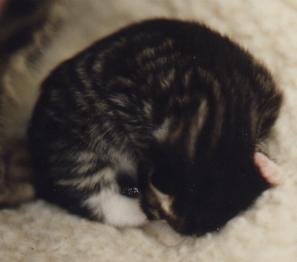
Premature kittens happen when the mother goes into labour early for some reason, including physical trauma (some traumas may necessitate caesarian delivery). Many vets avoid late-pregnancy abortions because the kittens are viable. Females who birth early may fail to nurse the kittens because the hormones triggering maternal behaviour are not released; she may even kill the kittens as a result.
Some pedigree breeds kitten two or three days early, without any problems. F1 hybrids of a domestic cat and a larger wild cat (e.g. serval) may be born on time as far as the mother cat is concerned, but at an earlier stage of kitten development because the wild species has a longer pregnancy. This means that the kittens are premature in terms of how well developed they are.
My own experience of premmies is from late-aborted kittens (at the owner's insistence) which were fostered by a shelter kitty who had given birth the same day. As with other orphan kittens, a foster mother is preferable as fostered kittens can suckle at will and get more maternal attention. Where not possible, a human foster mother is necessary.
The more premature a kitten is, the less likely it is to survive. Survival chances decrease rapidly for kittens more than 5 days premature. Kittens born more than 2 weeks premature are unlikely to survive. They are small, fragile and easily become chilled. Their lungs will be poorly developed and lacking in surfactant (the moisture which lines the airways in the lungs). Their digestive systems will also be immature and unable to cope with full-strength kitten formula.
It is very important that the kittens get queen's colostrum in the first few hours of life. This provides maternal antibodies giving them passive immunity to a number of diseases. To prevent stressing their systems, their first feed should be glucose solution (they cannot store glucose for long and burn it up at a tremendous rate) and then diluted milk solution. It is best not to feed full strength milk until the kittens reach their due date. This reduces the strain on their immature digestive systems. They will probably not increase greatly in weight until they have passed their due date.

Their sucking reflex may also be poor and they may require tube feeding. Kittens born more than 6 days early should be tube fed. Very premature kittens also require steroids and antibodies (administered by the vet) to help their immature lungs.
Premature kittens often resemble mice in that their tails, legs and ears lack fur. Sometimes the body fur may be so fine as to be barely visible. In general, the first week or so of their lives is spent reaching the full-development stage at which they should have been born. They don't put on weight at the same rate as a full term kitten because their bodies are expending energy on growing fur (up to 30% of their intake may be devoted to growing and maintaining fur) and "finishing off" immature internal organs.
When the fur has "grown in" they often gain weight rapidly. Because premature kittens must finish off crucial development outside of the womb, weight gain often begins later than in full term kittens e.g. a week later, though they usually catch up after several weeks.
A two week premature kitten will be at a similar stage of development to a normal few days old kitten, not at a similar stage to a two week old born at full term. I have found it helpful to think of them as "minus 2 weeks old", "minus one week old" instead of "a week old", "two weeks old" etc as this gives a more realistic idea of how fast they should be growing.
BASIC CONSIDERATIONS
When hand-rearing, you must minimise physical stresses on the kitten. Its actual rate of growth will depend not only on food and warmth, but on its state of health and whether it was born full-term or premature. Kittens do not all grow at the same rate - the figures quoted here are averages. Some will grow faster, some will grow slower. As long as the kitten is healthy, do not immediately panic if your kitten is not growing at the expected rate. If you are concerned at lack of growth, seek veterinary advice.
Not all readers will have state-of-the art facilities. Many cat-rescuers have worked wonders using improvised equipment and sheer hard work. The basic needs for hand-rearing are:
Common pitfalls include:
Remember that newborn kittens have immature systems which are easily stressed - their livers are poor at detoxifying drugs, their kidneys are inefficient. They cannot store glucose for long and they cannot regulate their body temperatures for the first few weeks. Minimising stress to their systems is essential.
WARMTH
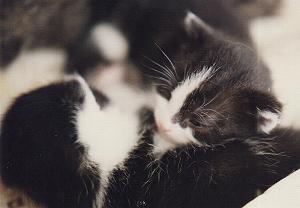
Kittens cannot control their own body temperature. They cannot shiver. They instinctively form kitten-heaps, snuggling on and under each other (often sliding off the top and burrowing into the bottom of the pile) and their mother keeps them warm by having the snuggle up to her body. Cold kittens cry for attention, but quickly become hypothermic and can no longer cry. A kitten's temperature will also affect its ability to feed and to digest food.
Cold kittens must be warmed up slowly. Rapid warming can be fatal. In an emergency, newborn kittens have been warmed by holding them in warm water (i.e. up to their necks). Kittens warmed in this way must be dried in a warm environment.
Newborns are wet and chill rapidly as they dry. The ideal solutions are an incubator, heat lamp (infra-red - not placed too close to kittens, not in a small enclosed space and with care not to overheat them) or heated pad. If these are not available, wrap a warm (not boiling) hot water bottle or microwavable pad in a towel and lay the kittens on this. Cover them with a section of blanket or fleece (fleecy side inwards). Fix a thermometer inside the box to check the temperature.
Suggested kitten nests are fleece (e.g. VetBed) which must either be washable or disposable; towels or blankets. These can be placed in a low-sided box (disposable) or crate (washable). Initially, divide the box or crate into compartments because very young kittens have such a strong urge to suckle that they may start to suckle parts of each other's body, leading to skin lesions which are an infection risk. The kittens remain in separate compartments until they are three weeks old. After three weeks, kittens NEED social contact and they like to huddle together. If the suckling is still excessive and causes skin sores, separation will be necessary for a little longer.
Caution: If using a plant propagators as an emergency incubators, be extremely careful of the temperature; heated plant propagators, or propagators placed on top of a heat pad, may get too hot for kittens as the heat is not easily dissipated.
|
KITTEN AGES |
RECTAL TEMPERATURE |
ENVIRONMENTAL TEMPERATURE |
|
Newborn - one week/ten days |
95 - 99 oF |
85-93 oF (29.4 - 34.0 oC) Nest box must be large enough for the kittens to move away from the heat source if they become too hot. Where there are a number of kittens they may need less heat because they will form a kitten-heap. |
|
One week/ten days |
95 - 99 oF |
Gradually reduce temperature to 80 oF (26.7 oC) by 7-10 days if the kittens are thriving. |
|
Two -three weeks old |
97 - 100 oF |
80 oF (26.7 oC) and gradually reducing as kittens grow |
|
Fourth week onwards |
100 - 102 oF |
As above |
|
30 days |
100 - 102 oF |
gradually reduce temperature to 72 oF (22.2 oC) by the end of the first month. |
|
BODY TEMPERATURE |
FEEDING DETAILS |
|
91.4 - 93.2 oF (33.0 - 34.0 oC) 93.2 - 95 oF (34.0 - 35.0 oC) 95.0 - 95.9 oF (35.0 - 35.5 oC) 95.9 - 96.8 oF (35.5 - 36.0 oC) 100.4 - 101.3 oF (38.0 - 38.5 oC) |
Nil by mouth! Electrolytes only! Digestion cannot occur below 95 oF Birth temperature 2-3 weeks old 4 wks to adult |
Note: A kitten with a body temperature below 94oF is clinically hypothermic and likely to die/may already be dying. Its digestive system does not function at this temperature.
ENVIRONMENTAL HUMIDITY
Low humidity and poor liquid intake leads to dehydration. Signs of dehydration are poor skin elasticity and sticky mucous membranes (gums). You can determine dehydration by the skin pinch or "tenting" test. Gently pinch the kitten's skin around the shoulder blade. Pull it out just a little way i.e. "tent" it. When released, it should immediately return to normal. If it remains tented, the kitten is badly dehydrated and probably needs injected fluids. If it returns slowly to normal, the kitten needs rehydration fluids.
Maintaining a humidity of 55% - 65% in the incubator or nest box prevents the kittens' skin from drying out. Humidifiers can be as simple as a shallow dish of water or wet towel placed on a warm radiator. A steaming kettle (be careful of boiling water) will provide instant humidity in the room, but must be switched off and placed somewhere safe after use.
ELIMINATION (URINATION & DEFECATION)
Kittens cannot urinate or defecate unaided during their first two weeks (approx). The mother normally stimulates these function by licking their lower belly/anal region. Where the human foster mother is entirely responsible for the kittens, this must be mimicked using moist cotton wool or moistened tissue.
A kitten must past urine and faeces at least once per day. Always stimulate a kitten's elimination functions after waking it up. After each feed is also good time - since you will be cleaning up milk spillages as it is. If they don't eliminate each time, don't force the issue - you could abrade their delicate skin. If they become constipated (a few do) see your vet. Very occasionally an enema is required.
At 2 - 3 weeks old, the kittens should start controlling their own functions. Placing them on the litter tray should trigger the reflex to urinate and/or defecate. Leave a small amount of soiled litter in the tray to build up a scent association for the kitten.
GROWTH RATE

Keep a log of the kittens' weights. Accurate digital scales are best for weighing, but good kitchen scales will suffice. Weigh them daily (twice daily is even better) at the same time each day until they are fully weaned and are obviously thriving. Full-term kittens should double their birth weight in the first 7-10 days, then continue to gain weight steadily. Premature kittens gain weight more slowly until their bodies reach the stage of development of a full-term kitten. Keep an eye on whether the kittens are gaining/losing weight or there is no change.
Kittens which have suffered a setback e.g. illness may lag one - two weeks behind in growth. Premature kittens may not begin their growth increase until after the day they should have been born.
When keeping records, it is easy to become confused if you have a litter of several near-identical kittens - especially when you are doing a 2 a.m. feed and are on auto-pilot. A dab of nail varnish on a claw will help to distinguish between kittens. Either use a different colour for each kitten, or paint the claws of a different paw on each kitten. When keeping records, make a note of the kitten's nail varnish colour or pattern (more on record-keeping later).
SIGNS OF ILLNESS
Kittens can deteriorate rapidly so better safe than sorry when it comes to signs that something is "not quite right". If in doubt, seek veterinary assistance. If the mother is present, but you are aiding the rearing process, take her to the vet with the kittens - she might have mastitis or an infection etc. Normal kittens spend 90% of their time eating and sleeping during their first 2 weeks. Signs of problems include:
Note
: Fading kitten syndrome is a well-known problem and has many causes. This includes blood-type mismatch akin to the human Rhesus factor.COLOSTRUM
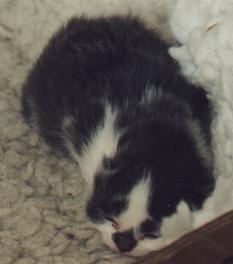
Kittens are sensitive to disease and infection. Kittens which did not get any mother's milk are at increased risk. In first 1 - 2 days after the birth, a mother cat secrets a special milk called colostrum which contains vital antibodies. These maternal antibodies (including antibodies triggered by vaccination of the mother cat) give the kitten immunity to many kinds of disease and infection. Without colostrum they are more susceptible to disease. Colostrum also contains more protein and less lactose than normal milk and it is rich in vitamins A and D - the first 36 hours are the most crucial hours of a kitten's life, the rich colostrum also helps it recover from birth trauma.
Kittens absorb colostrum and its maternal antibodies in their small intestine, maximum absorption is within the first 8 hours. At 12 hours old, the kitten loses the ability to absorb antibodies. Some vets can provide artificial colostrum (its effectiveness is debated) or early vaccination with special killed vaccines at 2-3 weeks of age. This varies from country to country.
At first (before the socialisation stage), keep the kittens isolated from other kittens. You may have to take the calculated risk of fostering them onto another nursing female. If there is a chance of a surrogate feline mother becoming available, this is usually better for the kittens than hand-rearing by humans. Weigh up the pros and cons of each individual case. Is the potential surrogate mother healthy? Are the other cats and kittens around healthy and vaccinated? Before handling tiny kittens which are being kept isolated, wash your hands thoroughly or wear disposable medical gloves. It is a tough decision, but if the kittens are to grow into normal cats they will need to mix with other cats, people (and possibly other animals) during the sensitive socialisation stage (3 to 8 weeks).
Note: Antibiotics are not a substitute for colostrum. The routine "preventative use" of antibiotics is not recommended as it help the development of drug-resistant bacteria and may weaken the immune system (just like muscles, immune systems need a workout).
TRANSPORTATION
You may be asked to collect orphaned or abandoned kittens from the finder. Use a closed sided carrier which has been sterilised and is lined with blanket or fleece. A warm pad may be placed under the fleece. If it is necessary for the kittens to spend more than a couple of hours in transit, you must stop to feed them and empty their bowels and bladder. Take a flask of warmed formula and necessary equipment (and some baby wipes!) with you.
Some kittens will arrive in less than ideal containers ranging from open boxes to garden buckets. They may need to be warmed up and/or treated for hypoglycaemia or hypothermia (see later sections). Check for any skin damage which might lead to infection. Also keep a close eye on them for signs of infection.
HYGIENE
When hand-rearing or providing supplementary care, disinfect your hands before and after handling kittens to prevent cross-infection with other litters. Also clean or replace the box or crate used as a nest. Cardboard boxes should be considered disposable, plastic crates should be used in rotation so that you always have a disinfected one ready while the other one is in soak or drying.
Avoid pine disinfectants (strong fumes) and any disinfectants which go cloudy when mixed with water. These are toxic to cats and more so to kittens due to their poor liver function. Your veterinarian can provide advice or sell you a suitable veterinary disinfectant. A weak solution of a sodium hypochlorite bleach may also be used.
In a situation where a safe disinfectant is impossible to obtain, freshly made salt water (boiled and allowed to cool) may prove effective.
FEEDING
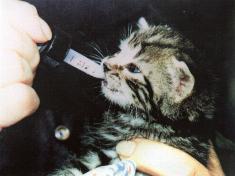
A mother cat produces very rich milk to enable kittens to grow rapidly. By comparison, cows’ milk contains less protein and fat and more sugar (lactose). A mother cat's milk changes over time to match the kittens' changing needs and growth rate. If the kittens' mother is feeding them but not producing enough milk (or has a large litter), you must supplement this with kitten formula milk. For orphaned/abandoned kittens or kittens where the mother cannot feed them, you must provide all of their food. By far the best solution is a feline foster mother with same age kittens (if her kittens are a different age, her milk may not be suitable).
There are a number of commercial kitten milk replacement (formula milks e.g. "Cimicat" in the UK) available from vets. Never feed kittens with cows milk - it will cause diarrhoea which can be life threatening. Do not use the "cat milks" from supermarkets, these are not kitten milk substitutes! Make the formula food up in strict accordance with manufacturer's instructions unless instructed otherwise by your vet. You will need a reduced volume if you are providing supplementary feeding only. You may need to strain the feed through a sterile cloth or plastic tea-strainer (small gauge plastic sieve) to remove any undissolved lumps.
If the instructions state "amount per 24 hours", divide this into a number of feeds. Approx 2ml every 2 hours to begin with (= 25 ml per 24 hour period). Two hourly is required to prevent hypoglycaemia (low blood sugar), a potentially fatal condition. The amount can be increased and the frequency decreased after 14 days. Do not overfeed - overfeed prevents proper digestion of food. At 2 - 3 weeks feed the kittens every 4 - 5 hours; at 4 weeks old it is every 6 - 8 hours. These are guidelines only and depend on the kitten's size, growth rate and state of health. It is, however, crucial to feed the very young kittens 2 hourly.
Warm the milk to 35 - 37.8 C (95-100 F). This is approximately the temperature of your forearm. If you use a microwave to warm the milk (not recommended it can easily burn small quantities), it must be left to stand until it has reached the correct temperature. After use, sterilize all utensils used for feeding kittens.
Water is needed to replace fluid lost in urine, faeces and breathing. Proteins are required for growth and maintenance of body tissues; kittens need more proteins than do adults because of their growth rate. Carbohydrates provide energy and may be converted to fat for storage. Fats are a source of energy. Some fats are essential for cell function. Vitamins and minerals are necessary for normal functioning of the body. If you can get it, commercial kitten food (liquid or solid) is carefully balanced.
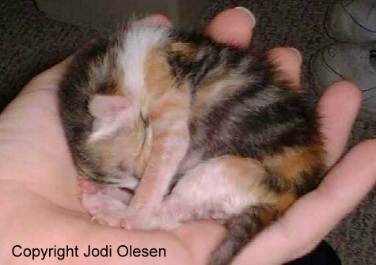
If commercial kitten formula is not available, a suitable feed mixture for healthy kittens is 1.6 ml evaporated milk, 1.6 ml cooled boiled water, 1 level teaspoon glucose, 1 small egg yolk (no white at all). One recommended by a veterinarian is 3 oz condensed milk, 3 oz water, 3 oz plain full fat yoghurt, 3 large or 4 small egg yolks (no whites). An alternative is kitten glop. These are not suitable for sick kittens.
If a newborn cannot cope with milk, give rehydration mixture to begin with. This should stabilise its condition. If it is healthy, introduce milk (mixed 50/50 with rehydration mixture) within 12 - 24 hours of birth. Gradually increase the proportion of milk until the kitten is on 100% milk made up according to manufacturer instructions.
Glucose solution is absorbed rapidly through the mouth tissues and can be a life saver for kittens without a suck reflex. Keep the kitten warm and use your little finger to stroke a drop of glucose onto the roof of the mouth and the front of the tongue. Continue this for up to 10 minutes, allowing the kitten to rest for 20 minutes between glucose feeds. Like any emergency treatment, it is not guaranteed, but sometimes it saves life. Do not feed glucose solution alone for more than 8 hours unless under veterinary guidance. The "traditional" drop of brandy is not recommended.
Probiotic or bio-yoghurt can be used to replace the beneficial gut bacteria after a course of antibiotics. Vitamin drops should only be used on veterinary advice or if the milk formula does not contain added vitamins. Most milk formulae already contain adequate vitamins.
|
METHOD |
ADVANTAGES |
DISADVANTAGES |
|
BOTTLE (with rubber teat) |
Baby bottles can be bought which are specially designed for kittens. The size of the hole in the teat (nipple) is important. Fill the bottle and tip it upside down - if it drips or dribbles freely, the hole is too large and there is a risk of drowning the kitten. Alternatively, if you have to squeeze the bottle hard, the teat is too small and the kitten will not get enough food (or may give up trying). It should drip when gently squeezed. As the kitten grows it will need a larger hole in the teat to deliver milk faster. Keep the bottle at a 45° angle. That helps keep the teat full of milk and not air. A feeding kitten should lie comfortably on its stomach or side. Gently lift its head towards the bottle. |
The hole must be correctly sized to regulate milk flow. Over time, the teat will become worn and the hole enlarges; worn teats must be changed for new ones. Kittens may become fixated upon one particular teat (a scent association) and may be reluctant to feed from a replacement teat. |
|
BOTTLE (open topped) |
Specially designed animal feeding bottles are glass, slightly curved with an open top and a rubber teat. The milk flow is regulated by how tightly your thumb is clamped on the open top of this type of feeder. When mastered, this gives excellent control of milk flow. The glass is easy to sterilise. A feeding kitten should lie comfortably on its stomach or side. Gently lift its head towards the bottle. |
Takes practice. The teat will become worn (as above). |
|
EYE DROPPER FEEDING |
Dropper feeding is similar to spoon feeding. Gently drip or dribble the milk into the kitten's mouth. Quicker and cleaner than a spoon or syringe method and usually safer. |
It requires practice to get good control of the dropper. Practice using water into a cup, not on a kitten. |
|
FINGERTIP/ SOAKED NAPKIN |
Improvised methods for an emergency where you do not even have a spoon. Soak the corner of a clean cloth napkin in milk and used this to drip milk into the kitten's mouth. |
Not sterile method and very slow. I have used this with a sickly 4 week old kitten using goats milk (in an emergency "in the field"). |
|
SPOON FEEDING |
Most people have access to a spoon. Gently pour each spoonful into the kitten's mouth. Do not elevate the kitten's head or milk may enter the windpipe. |
An emergency method. It is slow, messy and requires practice. New-born kittens have a poor gag reflex and milk can end up in their lungs causing drowning or aspiration pneumonia. |
|
SYRINGE FEEDING |
An emergency method, but with practice and a good syringe this can be manageable. I have used this method safely when giving supplementary feeding to kittens over 3 weeks old. |
If the plunger sticks and then suddenly gives way, a large volume of milk can end up in the kitten's mouth and lungs, causing drowning or aspiration pneumonia. |
|
TUBE FEEDING |
The cleanest and most efficient method. Requires specialist equipment, training and technical skill. Useful if a kitten's "suck reflex" is poor or the kitten cannot suckle properly (e.g. cleft palate where surgical correction will be performed later). Stomach tubes must be soft, flexible, blunt-ended and no more than 2-3 mm diameter. Suitable tubes are: premature human baby feeding tube or soft urinary catheter of the right diameter. Syringes should be 2 ml for small kittens, 5 ml for larger ones. Measure the tube to the correct length (from the kitten's nose to just behind the point of the elbow), and mark the tube at this point. This measurement will change as the kitten grows! Lubricate the exterior (e.g. with KY jelly) before insertion. Open the kitten's mouth by pressing gently at the corners. Keeping the head flexed downwards, slide the tube along the roof of the mouth, over the back of the tongue and down the back of the kitten's throat into the oesophagus. Pass the tube down until the mark on the tube is level with the nose. The other end of the tube will then be in the stomach. If any resistance is felt, withdraw the tube gently - it may have entered the lungs! If you have a stethoscope, listen to the kitten's chest - wheezing or bubbling sounds means the tube has entered the lungs. A syringe containing pre-warmed milk can then be attached, and the milk can be delivered slowly to the stomach. Make sure that the syringe does not contain any air. Wait a few seconds before removing the tube. |
The kittens have no control over how much they are fed and can easily be overfed or underfed. Kittens with a strong suck reflex are deprived of something to suckle. They may suck on each other and cause skin damage.Accidentally putting the tube into the lungs - this will cause drowning or aspiration pneumonia. If the kitten's head is kept flexed forward, it is quite difficult to miss the oesophagus or put the tube into the airway by mistake. Many kittens meow throughout the whole procedure - if they stop mewing the tube may be in the airway.This technique requires at least some training from veterinary staff. |
To encourage suckling, stroke the kitten's throat gently. Stroking the mouth on either side of the nose can encourage suckling in very tiny kittens. At the other extreme, greedy kittens should be given half of a feed at a time. After feeding, gently tilt its head up and use your other hand to rub its back towards the tail - kitten-burping to get rid of swallowed air.
Keep a record of the time each feed is given, the type and amount given, whether or not the kitten urinates and/or defecates (and whether these are normal). Also weigh the kitten twice daily and record this. You can decrease the frequency of weighing as the kitten grows.
Kitten Glop is a suitable feed mixture for healthy kittens and is also good for lactating queens. Most recipes refer to American brand names which are not understood outside of the USA/Canada. I have converted these to generic terms and noted alternatives.
Ingredients
Notes
If you have canned goat's milk available, use this instead as it reduces the likelihood of lactose intolerance problems. Sheep's milk is even higher in fat but not generally available in cans.
Some recipes use 2 tablespoons mayonnaise, 2 tablespoons plain yoghurt and omit the corn syrup entirely.
Clear corn syrup (e.g. "Karo" brand in the US) is a concentrated glucose solution. It contains 15% - 20% dextrose (glucose), a mixture of other types of sugar and may be flavoured with vanilla. Dark corn syrup is made with molasses and is more strongly flavoured.
Glucose solution may be used instead.Raw eggs can be a source of salmonella. Do not use any egg white in the mixture, it can prevent other nutrients from being digested.
Kitty vitamins and/or acidophilus are sometimes added. Only add vitamins if the diet is deficient in them - vitamins can be dangerous in too high quantities (hypervitaminosis) and vitamin imbalances affect development.
Method
Boil the water and mix in gelatine powder. Add the other ingredients in the following order, mixing well after each addition: half of the canned milk, corn syrup (if used), mayonnaise + yoghurt, egg yolk (if used), remainder of the canned milk. Use either an egg beater or a blender set to low speed.
Serve the glop at room temperature or slightly warmed since the kittens will be used to warm milk. Warming the mixture makes it more pungent and therefore more appetising. Do not pour back unused portions into the stored mix as it may introduce contaminants.
Glop sets into a jelly when refrigerated. It can either be stored in the fridge in a covered container for up to 2 weeks or frozen into individual portions in ice cube trays and defrosted as needed. Freezing it is very convenient, but it must be properly thawed before serving as cold food will cause stomach upsets in young kittens.
WEANING
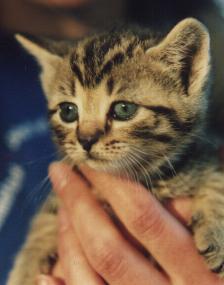
Weaning begins at 3-4 weeks of age. Start by teaching the kittens to lap their milk from a saucer. They can be encouraged by dabbing a drop of the milk onto their noses or encouraging them to lick a drop of milk from your finger. When they are lapping consistently, mash a small amount of kitten food into the milk to make a thin paste. As they progress from lapping to "shovelling" and then to eating normally, the amount of kitten food can be increased so that they progress from the paste to solid food. During this time a kitten's digestive system is adapting to cope with solid, meat-based food instead of milk. They can later progress gradually to dry food if that is your preferred food.
The kitten food used must be balanced, palatable and easily digested. Kittens need plenty of protein for rapid growth and high activity levels. Never use poor quality food just to save money - this could cause digestive upsets and stunt growth. Whether you use a commercial diet or a home formulated diet, it must be fully balanced. A vegetarian diet is not suitable - it lacks vital nutrients. Kittens need variety as long as this is not causing diarrhoea - feeding a variety of food prevents fussiness in adulthood. To avoid digestive upsets, only add a maximum of one new type of food in any 48 hour period.
Kitten glop can be adapted for weaning kittens. Mix in liquid cat food (e.g. Liquivite), pureed cat food, meat gravy or pureed baby food. If using pureed baby food, avoid any which contain onion or onion powder. Onion products cause Heinz body anaemia in cats; this is especially dangerous in kittens due to their low blood volume.
Avoid stressing the digestive system (e.g. over-feeding, hard-to-digest food, irregular meals) as this can cause diarrhoea. Less commonly, a kitten may be allergic to certain foods or ingredients. Kittens have small stomachs and need several small meals at regular intervals throughout the day. Kittens can eat two-three times as much as an adult! A well-fed kitten is active, healthy, grows well and has good bowel motions. Over-feeding causes obesity, lethargy and orthopaedic problems due to too much stress on bones and joints.
Weaning hand-reared kittens is a messy business. Be prepared for them to paddle in their food, shovel it around and get it all over themselves. Clean up the kittens before the food becomes encrusted in their fur or around their eyes and noses.
Note: Dried food can cause constipation if the kittens are not used to drinking additional water. Do not introduce them to dry food too early. Only use kitten or cat formula foods. That designed for dogs or humans lacks vital nutrients and may contain things toxic to cats.
RATE OF GROWTH & DEVELOPMENT
|
AGE |
STAGE OF DEVELOPMENT Note: premature kittens or kittens which have suffered a setback (infection etc) may be two - three weeks behind in their development. |
|
Birth - fourteen days: neonatal period. |
Body systems are at an early stage of development and unable to cope with stress. The most critical period is the first 36 hours. Neonates are born scraggy, but normally fill out within 24 hours and double their birth weight in 1-2 weeks. 90% of the time is spent sleeping or suckling. They should be relaxed and sometimes twitch in their sleep. When awake, they search vigorously for a teat (they can smell the teat). Eyes and ears are closed. They initially move with a swimming motion and start learning to walk once their eyes open. Kittens cry if they feel pain, are too hot, too cold or are hungry. Crying kittens should be attended to promptly. Continuous crying causes exhaustion which is fatal. They cannot control their own body temperature and are dependent on the environmental temperature. Hypothermia (chilling) is a common cause of death. Hyperthermia (heat-stroke) is also he fatal. They like to nestle up to something soft and form may kitten heaps with siblings - this helps to conserve heat.Newborns have a good sense of taste and should have a strong suck reflex. The suck reflex is actually developed before the kitten is born - premature kittens are often able to suckle. A young kitten has a tiny stomach which can only hold a small quantity of food. It needs frequent, regular, small feeds and cannot survive for long without adequate fluids. They cannot pass urine or faeces unaided. The first bowel motion is the tar-like meconium and has accumulated in the bowel before birth. It is sterile because the kitten's gut has not yet been colonised by bacteria. Early faeces is derived from milk and is dark yellow which gradually changes to a yellow-brown as the kitten grows. |
|
Fourteen - twenty-one days: transitional stage. |
The kittens become less focussed on the mother and more aware of their environment. They grow rapidly, sleep less and begin to explore their surroundings. They can react to discomfort by moving away from it. Although able to control body temperature, their small size means hypothermia and hyperthermia can still occur. Their eyes are open but weak and can be damaged by bright light. They are beginning to focus and will watch moving objects. Their ears should be open and they will react to sound.They are still reliant on milk as their main food, but may show an interest in cat food. By about 3 weeks old, a kitten can empty its bladder and bowels unaided and should instinctively use a litter tray. By three weeks, a kitten should be active and strong enough to romp and climb. Kittens which cannot support their own weight may have a skeletal abnormality e.g. flat-chest, limb abnormalities. |
|
Twenty-one days to twelve weeks: socialisation stage. |
Kittens are active and by four or five weeks of age they should be playing with littermates. If they have no littermates, the surrogate mother must provide play. It is preferable that they interact with other kittens or cats in order to learn proper cat behaviour. The kittens become increasingly independent and must begin to interact with people, other cats and with normal household items. They learn to purr and to meow. Between six and ten weeks there is a fearful period, this is also the optimum time for learning and traumatic experiences should be avoided. Kittens brought up "underfoot" are more confident. Also at this age, congenital defects (if present) might come to light. They have increasing control of body temperature and eyesight is improving and will continue to improve for several months. Hearing is acute by three or four weeks and kittens learn to determine what sounds mean. At three to four weeks they should squat when eliminating. At about the same time their first teeth are erupting. |
|
Twelve weeks to six months: juvenile stage |
The kittens are young adults and normally reach sexual maturity at 5 - 6 months OR when they attain their final adult weight. |
RECORD KEEPING
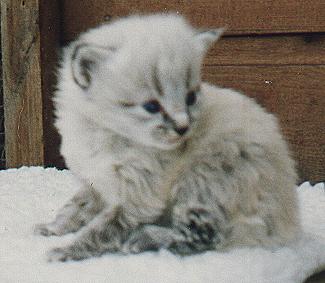
Whether you use a notepad or a spreadsheet, record-keeping is essential. Unless you keep records, you will not know if a kitten is progressing, stable or deteriorating. Good records mean you can seek veterinary help more promptly. The first thing to do is to check the kitten's general state to determine its chances of survival or whether it needs intensive nursing or immediate veterinary attention.
If possible record the date of birth and whether it was full-term,
premature or overdue. If not full-term, note how many days it was premature/overdue. This is not possible with "found" kittens so make a best guess based on the kitten's current size, weight and condition. All later weights will be compared to this initial weight to determine how well it is growing. Note whether it is behaving normally for its age, or whether it is precocious or slow. Is it restless, limp or normal? Does it cry more than it should? Is there any vomiting or diarrhoea?Check the rectal
temperature, weight and whether the kitten is at all dehydrated. If you have, and can use, a stethoscope check the heart rate - it is normally 200 beats per minute. You can also heck this by placing your little finger behind the kitten's left elbow. Either place the kitten to your ear or use a stethoscope to determine if the kitten is breathing normally or is it wheezing or rattling.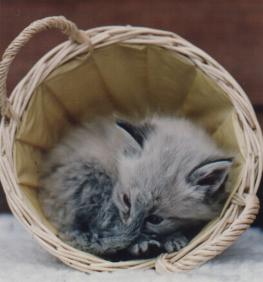
Check that the fontanelle is closed by using your little finger to stroke from the between the eyes towards the back of the head. If you can feel a soft patch or opening, the bones have not fused; if it does not fuse within the first week or the skull is deformed (
hydrocephalus) seek veterinary advice.Is the head a normal size and shape; are the ears and eyes normal for the kitten's age? Is there any sign of discharge from
eyes or nose? Are the gums and tongue healthy pink, pale (indicating anaemia e.g. due to flea infestation or kitten/mother blood group mismatch) or bluish (indicating oxygen starvation). Deep red indicates an infection. Dark blue indicates heart and lungs are failing - by this time there will be brain damage and death is almost certain. The mouth should be moist and warm with no obvious holes in the roof of the mouth (cleft palate) and the kitten should suck on your finger.Look for obvious defects or deformities such as
flat chest, hump-back, spina bifida, umbilical hernia or twisted limbs. Also check that muscle tone is good. Poor muscle tone indicates illness. Check for any infection at the navel and whether the kitten's belly is abnormally distended (recently fed kittens generally have pot bellies for a short while). Check that the kitten urinates and defecates when stimulated and that urine and faeces are normal. If no faeces is passed, check for imperforate anus.Full term kittens should have a full coat of hair (possibly sparse on the paws). Premature kittens usually lack hair on the lower legs and tail; some may appear almost hairless . Kittens with less fur will need plenty of warmth as they lack their own insulation.
![]()
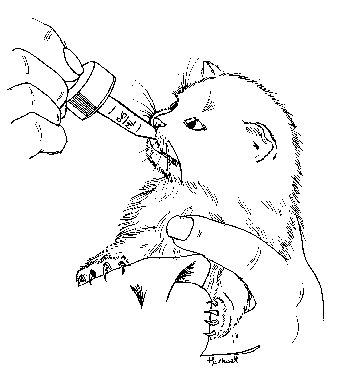
ANTIBIOTICS/ROUTINE ANTIBIOTICS
Only use antibiotics as and when prescribed by the vet to treat a known bacterial infection. Antibiotics are not a replacement for colostrum. They disrupt the normal colonisation of the gut by harmless bacteria; this can lead to diarrhoea and consequently to dehydration and death. Good hygiene should prevent the need for antibiotics.
Routine use of antibiotics (as sometimes used "preventatively" by breeders) does long term harm by promoting the development of drug-resistant strains of bacteria. It may also lead to an impaired immune system - immune systems need workouts too!
BEHAVIOURAL PROBLEMS IN HAND-REARED KITTENS
Hand-reared kittens are often said to have behavioural problems: nervous, aggressive, unsociable with other cats, over-attachment to their hand-rearer etc. Kittens need to socialise with other kittens or with adult cats. They learn from watching other cats and interacting with them. A hand-reared kitten which had plenty of contact with other cats and kittens will probably grow up to be utterly normal (possibly very affectionate with humans, but not to the point of being behaviourally abnormal).
Note: There is a trade-off between the risk of infection and the need to socialise a kitten. Ensure that all animals and humans who come into contact with the kitten are healthy (cats must be vaccinated). A poorly socialised kitten makes a poor pet and may be unhomeable.
CLEFT PALATE
Cleft palate means that the hard and/or soft palate failed to fuse during uterine development. Essentially there is a hole in the roof of the mouth connecting the mouth and nose. The degree of cleft palate ranges from tiny holes to a large central fissure running from front to back of the roof of the mouth and affecting the upper jawline (hare-lip). Sometimes both palates may be completely absent. There is a possibility that heredity is involved (e.g. due to short or broad facial shape in Persians and Exotics). Generally cases are random and due to abnormal foetal development in the womb, possibly due to metabolic disturbances, drugs given to a pregnant cat, to chemicals or radiation.Effects depend on the severity of the deformity. Milk is forced through the holes and into the nasal passages. It trickles or bubbles out of the nostrils during and after feeding. Kittens may sneeze when suckling. The amount of milk exiting from the nostrils affects growth (less milk reaches the stomach). Milk may enter the lungs causing respiratory infections such as aspiration pneumonia or even drowning. The reduced amount reaching the stomach may lead to starvation.
Small holes may cause lesser problems, but the holes cannot heal if the kitten is allowed to suckle. These kittens should be tube-fed to allow the holes to seal shut. Fine holes may close over in approximately one week. Larger holes or fissures will not heal unaided. The kittens must be tube-fed until it is robust enough for surgery at 6 - 8 weeks old (soft palate) with repair of the hard palate at approximately 6 months old. After surgical repair the cat can lead normal lives. The problems involved in rearing affected kittens means that euthanasia is usually advised. If a hereditary cause is suspected, do not breed from affected animals.
Hare lip is often seen with cleft palate cases, and Merlin (below) is showing his hare lip and demonstrating that normal life is possible after repair! Merlin's owner is Alisha Pierce, NC, USA who sent Merlin's photo to Messybeast.com. She says "I noticed there was no mention of cats surviving after birth with cleft palate and hare lip. I have such a cat, he's about 7 years old now. None of the veterinarians I've been to had ever seen a cleft palate survivor. I've never found any studies on their survival, or even a photo of a cat such as my Merlin."
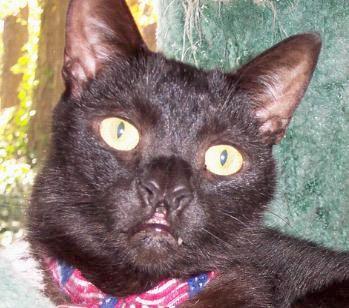
A general term for abdominal pain. Classic colic in infants is usually caused by an accumulation of gas in the stomach which causes the abdomen to swell. Gas trapped further along is "trapped wind" and causes similar pain. The abdomen becomes hard and bloated and the kitten shows signs of distress which may agitate the mother. Colic may be caused by overfeeding, bacterial infection, incorrect milk mixture, feeding too fast.
Because the mother becomes distressed, remove the kitten from the nest to treat it. Abdominal pain will be eased by releasing the gas build-up. Gently stroke the abdomen with warm damp cotton wool until the gas is released from one or other end of the kitten. If the gas is not released, seek veterinary help. The kitten should be fed little and often once it recovers. If it is prone to colic it may need preventative measures e.g. 0.5 ml Asalone (from chemists) 30 mins before feeding.
If all kittens in a litter are colicky, there is a problem with the mother's milk. Some mothers produce too strong milk. Antibiotics given to the mother can cause colic in the kittens. In these cases, hand-rearing is necessary.
This is fairly common in hand reared kittens. A mother cat stimulates a kitten's anal region frequently. A human surrogate may only stimulate it two or three times a day. Kittens should be stimulated to pass a bowel motion after every 3 feeds otherwise faeces accumulates in the rectum and colon. The longer faeces remains in the colon, the more water is reabsorbed from it and the drier and harder it becomes. This in turn makes it harder to expel the motion. Build-up of faeces in the rectum and colon can be toxic. A constipated kitten may have a hard, distended or tender abdomen. If it strains to defecate this can cause prolapse of the anus.
Normal kitten faeces has the consistency of toothpaste and is easily passed. If it becomes more solid, the kitten strains to pass bowel motions. If a kitten has not had a bowel motion for 48 hours, a small dose of liquid paraffin or a feline laxative (e.g. Katalax) is needed. Dosage for liquid paraffin is approx 0.5 ml per feed during the next 48 - 72 hours, less if bowel motions return to normal earlier. Liquid paraffin is not suitable for young kittens as it can irritate the intestine. Working a small pat of warm Vaseline (or equivalent white petroleum jelly) into the anus often acts as a gentle suppository. Recurrent or persistent constipation requires veterinary treatment e.g. a glycerine enema.
Dehydration is a common cause since this causes hard, lumpy bowel motions. Underlying dehydration must be corrected. Another cause may be the mother's failure to stimulate defecation. She can be encouraged to lick the anal area by smearing it with a little meat jelly or similar.
Dehydration occurs when a kitten either has insufficient fluid intake or excessive fluid loss. Diarrhoea and vomiting quickly lead to dehydration. It can also occur if a kitten cannot suckle properly or is not prevented from suckling (e.g. the runt) in which case hypoglycaemia may occur first. Use the skin pinch test for dehydration. Other symptoms are dark, concentrated urine. It may be impossible to stimulate urination. Faeces becomes hard and lumpy due to excessive dryness. This leads to constipation. The paw pads become flat, not plump and the mouth feels dry to the touch. See also malnutrition as these conditions are often associated.
Rehydration.
Rehydration solutions are a mixture of glucose and electrolytes (essential mineral salts in balanced proportions). Rehydrate the kittens with glucose and electrolyte solution (e.g. Lectade, isotonic glucose) little and often. Initially give 1 - 1.5 ml (depending on kitten's size: roughly 1 ml per 100g bodyweight) every 20-30 minutes until the kitten is rehydrated and can urinate when massaged. Weak kittens will require tube-feeding. When its condition improves, gradually increase the amount and decrease the frequency. If all goes well, diluted milk can then be introduced after 24 hours, and full strength milk 24 hours after that. For severe dehydration, parenteral (injected) fluids must be administered by a veterinary surgeon. Constipation will require an enema administered by the vet.
To make an emergency rehydration mixture: 500 ml cooled boiled water, 12 grams glucose powder, quarter teaspoon salt, pinch of sodium bicarbonate. It can be stored for 24 hours in a refrigerator. Electrolyte solution can be fed by itself for up to 24 hours after which a 50/50 mixture of electrolyte/milk can be fed and the proportion of milk gradually increased to 100%.
Glucose Solution:
Dissolve 5 grams of glucose powder in 30 mI cooled boiled water. Do not feed glucose solution alone for more than 8 hours unless under veterinary guidance. Glucose solution is absorbed rapidly through the mouth tissues and can be a life saver for kittens without a suck reflex. Keep the kitten warm and use your little finger to stroke a drop of glucose onto the roof of the mouth and the front of the tongue. Continue this for up to 10 minutes, allowing the kitten to rest for 20 minutes between glucose feeds.
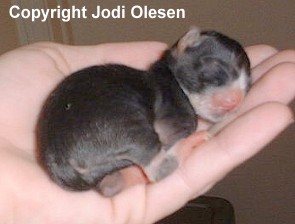
Prevent dehydration from recurring. You must identify the cause. Any problem with maternal milk supply usually affects smallest, weakest kitten first (i.e. the runt of the litter). Gradually it will affect the other kittens until the cause is identified and remedied. Some common maternal causes are:
a) Inadequate milk supply. Milk is produced on a supply and demand basis and is stimulated by the kittens kneading the nipples. Massaging the mammary area may stimulate the milk supply. Make sure the mother has adequate fluids herself or she cannot keep up with demand.
b) Congested milk glands. One or more milk gland might be congested. Matted long hair can prevent the nipples being reached - you may wish to trim or carefully shave the belly area. Many kittens become attached to one particular nipple and if that nipple is affected, the kitten may suffer. Congested milk gland require prompt treatment to prevent mastitis. Carefully massage the enlarged gland with a human breast cream (available from a pharmacy), then gently express milk from the nipple. When milk is flowing freely place the strongest kitten on that teat to empty the gland. Watch the mammary area during the first few days after kittening (or first few days after treating a problem) until the supply matches the demand. Mastitis requires veterinary treatment and antibiotics. If a kitten suckles from an infected mammary gland, the kitten may develop gastro-enteritis. If he mother is consistently unable to suckle her kittens, you must feed them for her.
c) In some Mediterranean countries where spaying is not common, a queen's nipples are sometimes sliced off by the owner. This prevents kittens from suckling and they therefore starve. This is not a humane method of population control and risks infection to the female as well as causing suffering to kittens. In such cases, cat rescuers must either hand-rear the kittens from birth or euthanize them promptly. If hand-rearing, the kittens will not be able to receive colostrum from their mother. The mammary area will be scarred, possibly infected and may contain milk which cannot be expressed. It is important to spay (or euthanize) the mother to prevent further suffering to herself or to potential future litters.
d) Sore nipples may occur quickly if kittens’ nails become extra sharp. This makes the female reluctant to let her kittens suckle. Carefully trim the sharp ends of the kittens’ claws. Apply breast cream to soothe the queen’s mammary area.
e) A female who has borne several litters may develop thickened and enlarged teats. Small or weak kittens may have difficulty sucking from these.
f) Excessive competition in a litter, or a large litter, can prevent the weakest kitten(s) suckling adequately. Ensure that those kittens have a chance to feed by removing the stronger kittens from the nest for short periods of time (if the mother permits handling). Alternatively, hand-rear or foster the smallest kittens
g) Some female cats are restless and do not allow their kittens to suckle adequately. Some are easily disturbed and the situation can be corrected by leaving her undisturbed (but you must still monitor the kittens e.g. through a window or hatch). Others lack proper maternal instincts. In some cases there may be a medical cause. Get your vet to check the mother for a possible causes e.g. retained kitten and/or placenta, raised temperature, mammary problems.
DIARRHOEA, GASTRO-ENTERITIS, ENTERITIS
Severe Diarrhoea or severe Gastro-Enteritis is a serious inflammation of the stomach and intestine which causes abdominal pain, severe diarrhoea and often vomiting. It quickly causes dehydration and electrolyte loss due to excessive fluid loss. The kitten may cry in pain if it has the strength to do so. Seek immediate veterinary help. Antibiotics may be required to combat infection. If and when the condition stabilises, the kitten may be too weak to suckle and may require tube-feeding.
Milder cases of diarrhoea are serious, but can often be corrected by the hand-rearer (if it persists, seek veterinary help immediately). It may be caused by overfeeding, milk replacer too concentrated, inappropriate diet, digestive intolerance/abnormality, viral or bacterial infections. Kitten faeces normally has the consistency of toothpaste and be yellow-brown in colour. Loose, yellow diarrhoea is a sign of over-feeding or feeding a too rich milk mixture. White diarrhoea indicates an intolerance to the milk formula. Foul smelling diarrhoea is a sign of E coli infection. As well as fluid loss, diarrhoea can cause a bowel irritation which aggravates itself. The bowel must be allowed to rest. Frothy vomit is associated with Feline Infectious Enteritis.
Swift treatment is essential as dehydration, collapse and death can then happen very rapidly. If kittens become collapsed and dehydrated they need immediate veterinary attention if they are to survive. Kittens in a collapsed state become chilled very rapidly. They will usually be given subcutaneous fluids by the veterinary surgeon.
Treat mild cases by diluting the milk 1:1 with boiled cooled water, which should be given until the diarrhoea stops. Severe cases should not be given milk, but given 5-10% glucose, glucose-saline, or isotonic electrolyte solution (e.g. "Lectade"), all of which can be obtained from a veterinary surgeon. These solutions should be given until the diarrhoea stops. Afterwards introduce milk diluted 1:1 with water, gradually returning to full strength milk 12-24 hours later. See: rehydration
If the condition has not improved after 12 hours, seek veterinary advice. If the condition stops when electrolytes are fed, but recurs after returning to milk the problem lies with the formula used. A further period of electrolytes is needed to settle the gut, after which a different formula must be used. If you suspect that the kitten cannot digest one particular milk formula, seek an alternative (with veterinary advice) and introduce this after electrolytes instead of the original formula. If the cause was too rich milk, feed a more dilute mixture. Note: some kittens are less tolerant of lactose than others.
Feline Infectious Enteritis is a major killer of feral and stray kittens and a hazard in cat rescue/shelter situations. Care must be taken to avoid cross-infection.

Kittens' eyes usually open within 1-2 weeks. Gummy eyes are most often due to infection. Failure to treat the infection can lead to blindness. If the closed eyelids become swollen or matted with pus seek veterinary treatment. Conjunctivitis is quite common in kittens and is treated with prescribed antibiotics. It is contagious (spread by contact) and can be transmitted from kitten to human and vice versa. Good hygiene is essential to prevent cross-infection. Wash your hands/any utensils after handling or feeding an infected kitten. Gummy eyes are also associated with Cat Flu, more common in stray or feral kittens as the mothers are unlikely to have been vaccinated.
Note: Conjunctivitis in humans needs prompt treatment as it can become very painful. On the plus side, after many years of handling gummy-eyed kittens I have thankfully become almost immune to many of the bacteria involved (i.e. my own immune system deals with them swiftly).
A few kittens' eyes open prematurely and there is a risk that they will dry out so regular eye drops are needed. Many such kittens do not survive. Sometimes, a vet will stitch the lid closed temporarily. Entropion (turning in of the eyelids so that lashes scrape the cornea) also leads to discharge.
Ultra-typed short-nosed or flat-faced breeds (Persians, Exotics) may be prone to blocked tear ducts and some lack tear ducts entirely.
If the eyes fail to open, check for micropthalmia (under-developed eyeballs) or anopthalmia (no eyeballs at all). Kittens with micropthalmia may have some vision. Whether or not to rear blind or partially sighted kittens depends on the likelihood of them finding permanent homes. Blind cats can lead happy lives if the household is adapted to their needs. See
Living With A Disabled Cat for more information.|
|
|
Anopthalmia (eyelessness). This kitten also had hydrocephalus which causes the highly domed skull. |
FKS is a general term used for kittens which fade away for no apparent reason within a few days of birth or sometimes at several weeks old despite earlier good progress. Various viruses and bacteria have been implicated. A mismatch between the mother's blood type and the kitten's blood type leads to maternal antibodies (in colostrum) breaking down the kitten's blood and leading to rapid fading. More recently, kitten diabetes has been found as a cause of some fading kittens.
A uterine infection can cause premature birth and the kittens will usually be underweight, wizened and scraggy. They will either have below normal or above normal temperatures and may be either hyperactive or very lethargic. Although they initially suckle normally, they do not fill out or progress like healthy kittens. They show signs of progressive weakness and stop suckling. With FKS, weaker kittens generally fade earlier; stronger kittens may not start fading for a couple of weeks. Affected kittens fade in spite of efforts to hand-rear them. They become weaker and less resilient, breathing may become more laboured and pneumonia may develop. The kitten then dies.
Another cause of "fading kitten syndrome" or "failure to thrive" is diabetes. While diabetes is commonly recognised in adult cats, it is rarely noted in kittens. Once the diabetes is detected and insulin treatment begins the kitten generally starts to thrive. Its weight and glucose levels need to be monitored carefully and its insulin dose adjusted accordingly until these stabilise (usually) in adulthood. Kitten diabetes is rare and little is known about the cause e.g. if there is a genetic predisposition.
As soon as fading is noticed in a kitten, get your vet to take rectal and throat swabs from the kittens (and vaginal swabs from the mother if possible) and also to test for diabetes. If bacteria are present, antibiotics may save the lives of those kittens which have not started to fade. They will need careful temperature control and plenty of fluids to combat dehydration. Many fading kittens do not respond to any treatment and post mortems may identify the cause of the problem.
Blood-type mismatch (Neonatal Isoerythrolysis) occurs when blood-type B mothers have blood-type A kittens (it rarely occurs the other way around). Maternal antibodies from colostrum destroy the kitten's blood cells. Some kittens may already be in decline from this when taken on by a human fosterer. Symptoms include dark brownish-red urine and severe anaemia. Kittens stop nursing after about 3 days, fade and die. Some kittens are less severely affected and appear to thrive, but their tail-tip may die during the first two weeks. Some have been saved by blood transfusion, but blood donor cats are unavailable in many areas and if available may not be affordable in a rescue/shelter situation. it is more common in purebred cats than in the moggy population.
Flea infestation of kittens is especially serious because they have a low volume of blood and a heavy flea burden causes anaemia which can lead to debility or even death.
Very young kittens are at risk of being poisoned by flea products intended for adult cats. Check with your vet for a suitable product for kittens and use only the recommended quantity. Very young kittens should be groomed with a flea comb to safely remove fleas. This is a tedious but necessary task. All kittens should be treated at the same time as the fleas will jump from one to the other when they nestle together.
Kittens from farmland may harbour bloodsucking ticks; these may have dropped off of the mother earlier or picked up from any grass the kittens have been deposited in (or carried through) by the mother. If you have suitable experience these can be removed using the pull-and-twist technique and special tick tweezers. A vet can remove them safely. While a small tick may appear to do no harm, there are tick-borne diseases. Several large ticks on a tiny kitten may lead to anaemia or at least put an additional strain on such a tiny creature.
HYDROCEPHALUS, OPEN FONTANELLE.
These occur where there is an excess of cerebro-spinal fluid in the skull. The fontanelle bones fail to fuse instead of fusing at the time of birth. The fontanelle is an opening which allows the plates of the skull to be compressed just enough for the head to pass through the birth canal. Open fontanelle is more common in breeds with domed heads or flat faces e.g. Persians. It is occasionally seen in random-bred kittens (I have seen a case of hydrocephalus where eyelessness was also present). It is usually possible to feel the soft spot at the top of the skull where the bones have not fused.
Affected kittens may not thrive as well as their littermates. Symptoms vary according to the amount of excess fluid in the skull. In severe cases, the skull appears enlarged with a prominent dome or forehead and exceptionally thin bones and the excessive fluid causes brain damage (which may be progressive). As the condition progresses, the pressure on the brain leads to blindness, convulsions, unusual behaviour e.g. compulsive circling and loss of control of limbs.
|
Kitten with hydrocephalus at various ages from 2 - 6 weeks. Compare the excessively domed skull and prominent forehead of the black-and-white kitten to that of its normal littermate. Hydrocephalic kitten was continuously assessed. Unfortunately its condition deteriorated as fluid continued to accumulate and it was euthanized at 8 weeks. Note: The hydrocephalic kitten also lacked eyeballs (anopthalmia) |
|
|
|
|
|
|
|
In mild cases where there are minimal or no neurological symptoms, the condition may resolve itself during the first few weeks after birth. The closure of the fontanelle has simply been delayed a little. Kittens with medium brain damage should be assessed for quality of life and likelihood of finding homes. Severely affected kittens must be euthanized.
HYPERTHERMIA, HEAT STROKE, OVERHEATING
Overheating occurs when a kitten becomes overheated e.g. environmental temperature too high. It is vitally important to identify the source of hyperthermia and correct it e.g. heat pads too hot, thermometer or temperature sensor broken, infra red heater too close to the nest or used in too small a space.
New-born kittens cannot control their body temperatures and are susceptible to hyperthermia. Symptoms depend on the severity of overheating. The body temperature becomes raised and the mucous membranes of the mouth become bright red. If the condition is not corrected, breathing becomes laboured. The kitten becomes cyanosed (bluish) and goes into shock. Fits or convulsions may also occur. There may be delayed complications such as renal failure.
Reduce the temperature slowly within 10 minutes by removing the kitten from the heat source. It may help to gently massaging the kitten with an ice-cube wrapped in a plastic bag or disposable latex glove (some kitten rearers keep damp sponges in plastic bags in the freezer). Try to keep the kitten dry. Be careful not to cause hypothermia through over-zealous cooling.
HYPOGLYCAEMIA (LOW BLOOD SUGAR)
Caused by inadequate or infrequent feeding; also when abandoned kittens are found and have not been able to nurse for some time (e.g. mother killed or driven away). Kittens up to two weeks old can store very little glucose in their bodies. Small kittens are also at risk. Kittens with a septic infection need glucose in order to fight the infection; they will need feeding every 2 hours day and night. In general, feeding every 2 hours prevents hypoglycaemia.
Symptoms are crying, dehydration, hypothermia, severe depression, muscle twitching, respiratory distress, decreased heart rate and eventually convulsions, coma and death. If not treated, the kitten becomes limp and goes into a coma, suffering severe neurological damage, convulsions and death.
First raise the kitten's temperature above 34°C (93.2°F). A few drops of glucose syrup placed on the tongue can save the life of a kitten showing signs of hypoglycaemia. Feed a small amount of glucose solution (see above for formula) or glucose/electrolyte mixture e.g. 0.5 ml - 1 ml every 30 minutes. Gradually increase the amount given and reduce the frequency. Do not be tempted to make a strong glucose solution - this can cause diarrhoea and dehydration. Re-introduce milk gradually, first in a 50/50 milk/electrolyte mixture, gradually increasing the proportion of milk to 100%.
If the kitten is limp and has no suck reflex, gastric tube or subcutaneous fluids are required. Even so, the kitten may not survive due to damage already suffered.
If the hypoglycaemia is due to the current feeding regime, increase either the amount and/or frequency of feeding to prevent re-occurrence.
This is a frequent cause of neonatal death. Kittens have no control of their body temperature at first. Their small size means they quickly lose heat. Their inability to store glucose for long means they run out of metabolic fuel which would generate internal heat (hypoglycaemia). Hypothermic kittens feel cold and limp. Their blood pressure drops, their circulation slows and their paws, abdomen, tongue and gums become pale (then bluish) due to reduced oxygen supply. The vital organs and digestive system cannot function at low temperatures or with reduced circulation. The kitten will become comatose if not treated promptly.
Hypothermia frequently occurs with Hydrocephalus, Fading Kitten Syndrome, shock etc. Kittens with pale mucous membranes may respond to treatment. Those with blue or purplish membranes are likely to be beyond help due to circulatory collapse. They will have suffered permanent damage to the internal organs and brain damage due to lack of oxygen.
The first priority is to SLOWLY raise the kitten’s temperature e.g. over a couple of hours. Too fast and the kitten will go into shock and may suffer heart failure. Wrap the hypothermic kitten in a piece of towel or cotton fabric with its nose and mouth left uncovered. Place the wrapped kitten in a warm box at 30°C (86°F) e.g. on a warm hot water bottle, heated pad or using an incubator. Turn the kitten over at regular intervals. Adjust the temperature in the box as the kitten warms up so it does not become overheated. As it warms up, its gums etc will become pink as circulation improves. Do not feed milk to a hypothermic kitten - its digestive system will not be working. If its rectal temperature is less than 35°C (95°F), the milk will stagnate in the stomach and cause further problems.
If there is no suck reflex tube-feed the kitten with glucose and electrolyte solution. If the suck reflex has not returned when the kitten's temperature rises it will need subcutaneous fluids. When the sucking reflex is present, feed with a small quantity (up to 1 ml) of glucose solution every 20 to 30 minutes. After 2 or 3 such feeds, it should be strong enough for the amount to be increased and the frequency decreased. Gradually reintroduce diluted milk feeds until the kitten is back onto normal strength milk.
Once they have been warmed up and given fluid therapy they must be allowed to recover quietly. Feeding can only be begun once the kitten is warm and able to suck. Stomach tubing is not helpful here, since when a kitten is cold and collapsed its intestines stop functioning, so stomach contents can be easily regurgitated, and then aspirated into the lungs.
LIMB PROBLEMS: LUXATING PATELLA (SLIPPING KNEECAP), TWISTED HIND LIMBS
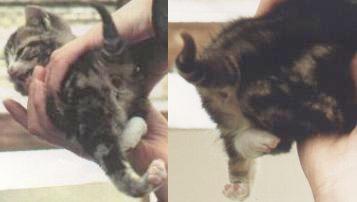
Either due to conditions in the womb preventing the limbs from being exercised or due to a weak kitten not exercising hind limbs after birth. With Luxating Patella, the affected leg(s) either stick out in a rigid position due to the kneecap slipping and locking the leg rigid. With twisted limbs, the limbs are curled under the kitten in a "lotus" yoga position. With a kneecap problem, manipulate the kneecap into position (usually a job for the veterinarian) and immobilise the leg in the correct position with surgical tape, strapping it to the body for 7 - 8 days to keep it immobilised. Do not cover the toes - you must check the paws and toes regularly for circulation.
With twisted limbs, physiotherapy and splinting is required early on, otherwise they will become fixed irreversibly in the twisted position. Twisted limbs usually respond to treatment over a few weeks. If a single limb fails to respond to treatment, amputation may be required later. If 2 limbs are affected or the limbs fail to respond, the prognosis is less optimistic.
Oxygen starvation can result from a prolonged or difficult birth. It is often the result of placental failure or umbilical cord obstruction during the birth or respiratory obstruction. Affected kittens are usually less active than their litter mates. The suck reflex may be weak or missing altogether. They are often too weak to survive unaided so it is essential to identify affected kittens quickly after birth and to start treatment promptly. In some cases there will be brain damage; mildly damaged kittens may go on to lead relatively normal lives. Severely affected kittens should be euthanized.
If the suck reflex cannot be stimulated, tube-feeding will be required at first. Feed 1 - 1.5 ml glucose solution (depending on kitten's size) every 30 minutes. If and as its condition improves gradually increase the amount and decrease the frequency. Gradually introduce milk feeds. If the kitten recovers fully it can be returned to the litter.
If the mother is placid and co-operative, you can try "aided suckling". Express a drop of milk from one of her teats and place the kitten on the teat (making sure it takes the teat into its mouth, just as you would if bottle feeding it). Hold it in place and stimulate it to suckle by stroking either side of its muzzle. You may also have to "tread" the mammary area with your fingers. The kitten should have short, frequent aided suckling session until it can suckle unaided. After each aided suckling session, weigh the kitten to check that it has fed. If not, you will have to bottle -feed or tube feed it.
A kitten that fails to recover or to show improvement within 24 hours is unlikely to survive; its brain and other organs have probably been irreparably damaged by lack of oxygen.
IMPERFORATE ANUS (ARTRESIA ANI)
This is the absence of an anus. It may just be the anus that is occluded (obstructed or does not have an external opening) or the entire rectum may be missing. Sometimes the anus is present, but does not connect to the end of the bowel. Imperforate anus means the kitten cannot defecate, or cannot defecate normally since the lower bowel may open into another orifice. Symptoms akin to constipation occur and visual inspection may show lack of an anus. If the kitten is being reared by its mother, it may be several weeks before its condition is noticed. If it is being hand-reared, you will soon notice a problem.
As soon as the condition is discovered, seek veterinary help. If the anus is just blocked or doesn't connect to the bowel, it may be possible to correct this surgically. Surgery must be performed immediately to prevent or relieve constipation. If a larger portion of the bowel is missing, euthanasia is recommended. If the kitten survives surgery (surgery on tiny kittens is risky), the prognosis is good though it may be some time before it gains proper control over its bowel motions and it may need to be manually expressed for a while.
This can occur before birth due to placenta problems. It also occurs in weak kittens e.g. runts or where the litter is too large for the mother to feed them all adequately. The runt is the first to suffer if there is a more general problem with lack of maternal milk supply. Malnutrition can also occur if the kitten cannot suckle (due to face shape, undershot/overshot jaw) or cannot stimulate the milk flow by "treading" (in radial hypoplasia kittens). Medication given to the kitten or to the mother and entering her milk can prevent the kitten's gut from digesting milk e.g. destroying benefical bacteria in the gut, damaging the gut lining.
Heavy roundworm infection can result in malnutrition. If the milk is strong and too acidic it can cause colic, vomiting and digestive problems. This will affect the entire litter. Malnutrition is also found in kittens found by rescue workers, especially kittens born in feral colonies where there is inadequate food for the mother to produce enough milk.
Malnourished kittens are small, weak and underweight for their size. They do not gain weight at the correct rate and they may cry frequently due to hunger. If malnutrition continues, it grows weak, lethargic, loses the ability to cry and the suck reflex is reduced. Hypoglycaemia, dehydration, hypothermia and diarrhoea may also occur.
First correct any hypothermia. When the kitten’s temperature is 35°C (95°F) feed with electrolyte solution (0.5 ml to 1 ml every 30 minutes). If the kitten has no suck reflex, it will need tube feeding. Medicate for diarrhoea if necessary. As the kitten improves, increase the quantity of feed and decrease the frequency. A special diet from the vet may be required until the kitten's gut recovers enough to digest kitten milk. When the digestive system has recovered, introduce milk, first in 50/50 mix with the electrolyte solution, gradually increasing the amount of milk until it is 100%.
PECTUS (PECTUS EXCAVATUM), FUNNEL CHEST
A deformity where the sternum (breast bone) presses into the thorax (chest cavity). It is sometimes known as "Funnel Chest" because the rib cage appears flattened and the breastbone collapses inwards as the kitten breathes. Mild pectus may be barely noticeable (unless the chest wall is palpated) and the kitten feeds as normal. Serious cases cause chest compression, reduced lung capacity, breathing difficulties and lethargy. The reduced oxygen supply causes poor growth and the kitten tires easily. In serious cases the kitten cannot suckle properly and becomes dehydrated and debilitated. An X-ray can determine the exact severity of the pectus. Often, pectus corrects itself as the kitten grows, but the kitten will need some supportive treatment. It must be tube fed and must be encouraged to keep pressure off of the chest e.g. to sleep or lie on its back or side, not on its front. If it does show a preference for lying on its front, resting it on a suitably shaped small soft pillow (or even a soft toy!) can help its breathing.
An inflammatory condition of the lungs. There are various types and causes. The most common ones are:
a) Aspiration pneumonia due to a kitten inhaling a substance which irritates the lungs. Usually this is milk which has "gone down the wrong way" perhaps due to inexpert hand-rearing or using unsuitable equipment. For this reason, bottle feeding is safest for kittens which can suck. Eye droppers or syringes should only be used if there is no alternative and with the utmost of caution. If a kitten does inhale milk or is rescued from drowning, prompt clearing of the lungs can prevent aspiration pneumonia. Hold the kitten firmly, and shake it sharply downwards supporting its neck (much like clearing a baby's lungs after birth).
b) Bacterial pneumonia is caused by a bacterial infection and must be treated with antibiotics as prescribed by the vet.
c) Viral infections can cause pneumonia or can make a kitten susceptible to secondary bacterial infection. Antibiotics cannot kill viruses, but are prescribed to treat those secondary infections.
Symptoms vary depending on the cause and severity of the pneumonia. Aspiration pneumonia occurs very rapidly. Breathing becomes laboured and irregular. The kitten may gasp for breath, become limp and have bluish mucous membranes due to lack of oxygen reaching the tissues. The kitten also develops a fever. These kittens must be treated by a vet if they are to survive. They require tube feeding and possibly injected fluids as well as antibiotics. They may also require oxygen to compensate for breathing difficulties.
The protrusion of one or more layers of the lower bowel through the anal sphincter. It may be caused by straining when constipated or, conversely, by chronic diarrhoea. A doughnut-shaped protrusion from the anus indicates prolapse of the lining of the rectum. A cylindrical protrusion indicates prolapse of all the layers of the rectum. Very gently push the prolapse back in through the anus. If the prolapse cannot be pushed back into position, if it recurs or if you don't feel experienced enough, seek veterinary help at once. Sometimes a suture is required to keep the prolapsed tissues in their proper place. Any associated conditions such as infection or dehydration must also be treated.
Pyrexia is raised body temperature which is not due to heat stroke. It indicates some form of infection. Seek veterinary advice. One trick for reducing a feverish kitten's temperature is to wrap alcohol soaked gauze around its paws to help cool her down. Paws are one of the few areas of a cat not insulated by fur and able to sweat. The alcohol uses body heat to evaporate. By restricting the cooling to a small area, the kitten is less likely to become hypothermic as it would if wrapped in chilled towels (their small body size means they chill quickly).
Respiratory distress is a symptom of many conditions including infection, aspiration pneumonia, near drowning, shock, heat stroke, fluid in the chest cavity. Irregular or shallow breathing indicates serious illness. Unless you can immediately identify and treat the cause e.g. treat heat stroke, seek veterinary advice immediately.
Respiratory problems may also be due to obstruction of airways e.g. with discharge from an infection, swelling from an injury, inhalation of clumping cat litter. If the obstruction is immediately obvious and visible you may be able to remove it yourself by bathing the nasal area. Obstructions inside the nose or windpipe require veterinary treatment. Some short nosed breeds may show respiratory signs related to their altered facial proportions.
Nasal discharges indicate various problems. Pus indicates an infection or foreign object inside the nose. Trickles or bubbles of milk indicate cleft palate. A bloody discharge may indicate serious lung problems and, unless the blood is obviously from a superficial wound, bloody nasal discharge requires immediate veterinary attention.
This is generalised infection i.e. the kitten’s system is filled with harmful bacteria. It may have picked up these bacteria in the womb, during birth or after birth through a skin lesion or umbilical cord. Kittens with septicaemia have a raised temperature and their gums and tongue are fiery red. They are distressed, restless and often keep rolling over where they lie. They cry with a pathetic ‘mew". Early diagnosis and prompt treatment are essential if the kitten is to survive. The vet will prescribe appropriate antibiotics. Such kittens are critically ill and require tube-feeding and attention to the environmental temperature. Many will not survive despite best efforts of vets.
If septicaemia has been acquired through the umbilical cord, you may see a small, pus filled blister at the umbilical area. This can be treated by bathing the blister 3 times daily with salt water until it blister erupts. Afterwards, dust the cord with wound powder (e.g. Ster-Zac) after each feed until the cord drops off and the navel has healed.
The common term for collapse resulting from circulatory failure. The heart is unable to supply all the tissues in the body with adequate blood keep them oxygenated. Without adequate oxygen, those tissues cannot function normally. Causes are numerous and include hypothermia; sudden blood loss from a wound, internal bleeding or from the umbilical cord. Blood pressure drops abruptly due to lack of blood volume. Heartbeat is weak, rapid and irregular (fluttery). Breathing is shallow. There is general weakness, possible loss of consciousness, drop in temperature, pale gums and tongue, reduced urinary output of urine and there may be trembling or shivering.
If the kitten is unconscious, seek immediate veterinary help.
If it is cold treat it as for hypothermia. Otherwise maintain its temperature carefully at 35°C (95°F). Overheating too quickly increases the degree of shock.
If it is conscious and has a normal temperature, give 1 - 1.5 ml of electrolyte solution (according to its size) every 30 mins. As it improves, increase the volume and decrease the frequency of the feeds. Gradually re-introduce milk feeds. It will probably be so weak that tube-feeding is required.
At approx 3 days old, kittens gain the ability to vomit on a full stomach. Vomiting is a general sign associated with many different gastrointestinal (stomach and gut) problems. Regurgitation resembles vomiting and is due to problems with the oesophagus e.g. obstructions, collapsed oesophagus and some systemic disorders. Vomiting quickly leads to dehydration. The appearance of the vomitus (undigested, partially digested) and the time between feeding and vomiting helps narrow down the causes.
If the vomit contains food, it indicates how long the food has been in the stomach. Mucus and fluid may be gastric or may be swallowed saliva. Yellow or green vomit is a sign of bile in the stomach. Fresh blood (amount varies from small flecks to large amounts or blood clots) indicate severe infection, internal injury or a blood clotting disorder. An appearance of coffee grounds is partially digested blood.
Occasional regurgitation immediately after a meal may be due to greed. However, swift veterinary help is needed, if kittens are vomiting. They will need treatment for dehydration and possibly subcutaneous fluids.

Kittens gain some protection from disease in the form of maternal antibodies passed in the queen's colostrum, (see earlier). To ensure that the queen has sufficient antibodies to pass onto her kittens, it is important that she is well vaccinated prior to mating. The protective effect of maternal antibodies lasts for only a few weeks.
The kittens' vaccination programme should start from approximately 8 weeks of age. The exact timing and type of vaccinations should be tailored to the kittens' or shelter's needs e.g. if there is a known problem with Cat Flu in the general area or a cat in care turned out to be harbouring a transmissible disease, you may want to vaccinate all vulnerable kittens in addition to your usual precautions. Your vet will be able to advise.
If the kittens were orphaned, and hence never received colostrum, they will have gained no protective immunity from their mother, and so may need to be vaccinated early, perhaps from 2-3 weeks of age. Most cats are vaccinated against Feline Infections Enteritis and the viruses that cause Cat Flu. Others are also vaccinated against Feline Leukaemia Virus infection and/or Chlamydia.
WORMING
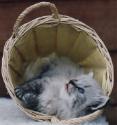
Intestinal parasites (roundworms, tapeworms) are common in kittens unless the mother was wormed before pregnancy began. With abandoned kittens it is impossible to know whether the mother was wormed or not. Feral kittens almost always harbour worms.
Healthy kittens should be wormed with a preparation recommended by your vet when they reach 5 weeks old. Thereafter they should be wormed as advised by your vet until they reach 6 months old and are wormed routinely as adults.
Sick kittens or kittens under 3 weeks old should only be wormed under veterinary supervision e.g. if they have a severe worm burden which is compromising their health and growth.
Before each dosing the kittens should be accurately weighed, since too little wormer will be ineffective and too much may cause illness. In many kittens the worms cause no clinical signs. In others they can result in poor body condition, soft or bloody stools, loss of appetite, pot-belly and weight loss.
Some worms can be transmitted through the stools of infected cats, while others are carried by fleas. As well as worming, good hygiene and flea control are essential.
Skin Lesions (wounds) can easily become infected. There are various types of skin lesion and infections e.g. bacterial infection of a bite or scratch wound, infection of umbilicus (navel), infection caused by the mother cleaning the kitten excessively (some have even bitten off a kitten's leg or tail), damage from kittens suckling on each other (more common in hand-reared litters than in kittens with mothers). Kittens which suckle on each other can cause haematomas (blood blisters) under the skin. In kittens, haematomas are serious as they can become infected. The kittens may need to be separated until weaning age to prevent them from suckling each other.
Wounds must be kept clean and fur around the wound may need to be shaved or clipped to make cleaning easier. Antibiotics or "wound powder" may be needed if wounds are inflamed or infected. Prevent further damage by finding the cause of injury. If the mother is harming her kittens, they will need to be hand-reared.

You are visitor number